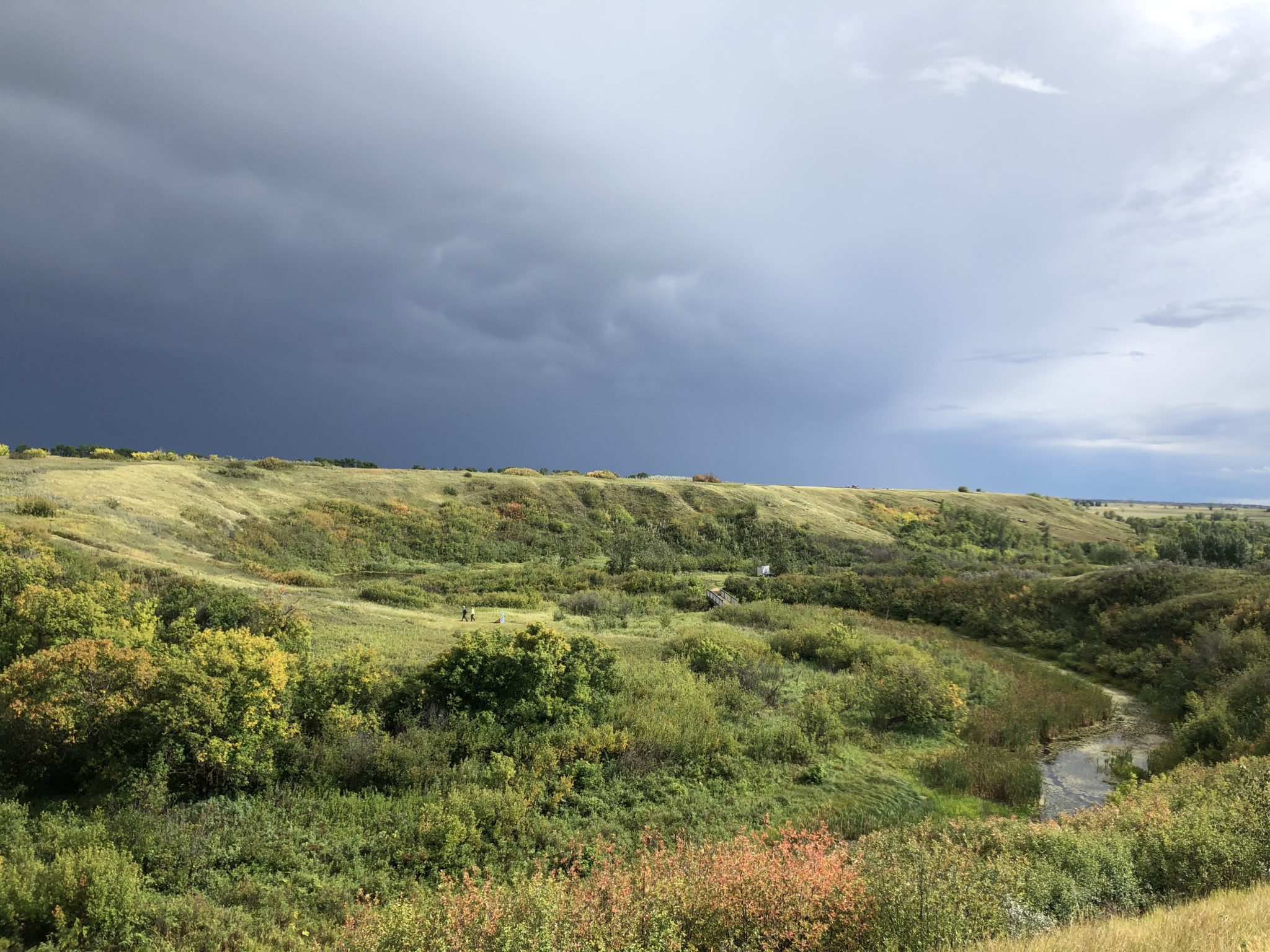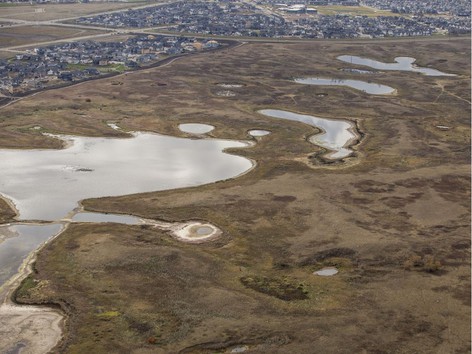Moving Urban Conservation Forward

By Stew Coles
The concept of urban conservation is not new but this last year – under the clouds of a global pandemic – has certainly brought this topic to the fore and more specifically how our natural urban landscapes are critical for our health and wellbeing.
For many years here in Saskatchewan our major towns and cities have advanced the notion and importance of green space, from developing green infrastructure strategies to ensuring key areas of our urban spaces remain wild, conserved, and accessible. This is very evident in Saskatoon when we consider its river valley and critically important habitats, for example, in the Northeast and Small Swales, Chappell Marsh, Cranberry Flats, and Beaver Creek Conservation Areas, and the ecological and culturally significant Wanuskewin Heritage Park and its wider landscape.
While we can see there is much to celebrate in this city, as we can also attest for with Regina’s Wascana Centre and Little Red in Prince Albert, there remains uncertainty around some of these critical habitats remaining the rich biodiverse ecosystems they are today as we are already observing the methodical destruction and fragmentation of these critically important landscapes.
Looking back to the start of 2020, we witnessed some disappointing municipal decision-making that could have long-term impacts on sensitive habitat and at-risk species within the Swale complexes of northeastern Saskatoon. We saw the city council increase speed limits through this habitat, a decision made against expert advice and the Northeast Swale Development Guidelines. Further commitments to infrastructure development in this region of the city – University Heights 3 residential development, Saskatoon Freeway Project, and Saskatoon North Partnership for Growth (P4G) Regional Plan – pose a significant risk to the natural function (ecological goods and services), biodiversity and ecological integrity of this landscape.
TRANSPARENCY
Limited public accessibility, delays, and refusals to share ecological data add further constraints to effectively determining ecological and cultural impacts and creates additional uncertainty as to the openness and broader intent of development plans, especially when we consider the wide scope of infrastructure proposals centered on northeastern Saskatoon.
We must ensure the general public, and other bodies, have access to current and relevant environmental data at the earliest opportunity. Effective and robust environmental data is a critical component at the engagement level, as it helps provide necessary perspective, aids effective and robust decision-making, and provides for a transparent process.
Our comments to and request for ecological data, related to these projects, are to ensure these critically important habitats remain functional, accessible and protected from further encroachment, degradation and fragmentation. It is further to ensure that this data is effectively informing decision-making and that avoidance, compensation and/or mitigation measures are fit for purpose.

THE CONVERSATION MUST MOVE FORWARD
While the unabated progress of infrastructure projects and municipal decision-making is a continued cause for concern in this area of Saskatoon, we must move the conversation forward and seek to collaborate on effective solutions to deliver the necessary protections and gains for urban and near-urban conservation.
Citizens must be more timely and better informed as to the value of urban conservation – from an economic, ecological, and cultural standpoint. This ensures knowledge is a shared commodity, enabling more open, honest, and effective conversations and outcomes. It is also an important measure for holding our elected officials and decision-makers accountable to the pressing need to protect and conserve our natural urban landscapes for the benefit of addressing biodiversity loss, climate change, and ecological services, and the important role and values we place on these environments for our health and wellbeing.
In the broader sense, we must find new ways to encourage and incentivize our municipalities and governments to see the merit – economic included – of protecting our most valued habitats and species in perpetuity and providing these landscapes with the necessary buffers and connectivity for both flora and fauna to thrive.
THE IMPACTS AND IMPORTANCE OF NATURAL URBAN LANDSCAPES
In addition to the value we place on protecting biodiversity, we must also recognize that our natural urban landscapes are many of our children’s first experiences of and with nature. We want these experiences to have positive impacts into adulthood. There is no mistaking that our youth are our future leaders, decision-makers, and guardians of the land.
Areas like the Northeast and Small Swales and Little Red in Prince Albert should be recognized as a catalyst for shaping and influencing one’s perspective, appreciation of and connection with the broader natural world, alongside nurturing our ability to empathize and engage with our natural surroundings in a more holistic, sustainable and caring way. Our natural urban landscapes represent a valuable learning experience and can be seen as an essential tool and space for all environmental advocates of tomorrow to better understand the workings of our natural world in the most tactile way possible.
“Healthy ecosystems supply us with the vital services that underpin all life on earth, such as clean air and water, food and fibre, pollination and fertile soils. Connection to nature also provides us with other significant benefits, such as a sense of place and identity, areas of spiritual and cultural importance, creative inspiration, intellectual curiosity and adventure.”
Tandi Spencer-Smith – Director of the Australian Committee for the International Union for Conservation of Nature (ACIUCN).



MUNICIPAL FUND FOR BIODIVERSITY – CPAWS DEVELOPED FUND
While on the back burner for a good part of the last year due to the pandemic, our plans to move the Municipal Fund for Biodiversity forward remains a top priority. Created with the purpose of being a solution and catalyst to investing in urban nature conservation through a collaborative approach, this fund has the opportunity to advance a broad spectrum of projects linked to addressing biodiversity loss, the restoration, enhancement, and protection of natural urban landscapes, and to contribute to climate change adaptation and mitigation.
Conversations are advancing quickly around the protection and land use status of Little Red Park in Prince Albert and we will continue to monitor its progress and provide support where possible. Saskatoon remains a key area of conversation regarding this fund and its potential to identify conservation projects within the city. We have not yet identified any key urban or near-urban areas within the City of Regina at this time that may benefit from this fund, but as the fund develops, we hope these important conversations can be broadened to other municipalities in Saskatchewan.
WHAT IS NEXT?
CPAWS-SK remains engaged in urban and near-urban conservation discussions and will continue to broaden our engagement at a local, regional, and national level to ensure the opportunities for and values of urban conservation are shared and prioritized.
We are also keen to hear from our supporters about the natural landscapes that matter to you in and around urban centers in Saskatchewan. We have clearly entered a critical era where we are all too aware of the many drivers of change on the natural world and the impacts climate change and biodiversity loss are having on our habitats, wildlife, and our own wellbeing.
CPAWS-SK wants to ensure nature has the best possible means to thrive and continue to be the biodiversity-rich and accessible landscape for species and people alike. Protecting our native grasslands, natural wetland systems, forests, and the wide and plentiful variety of flora and fauna they attract, including rare, endangered, and at-risk species, is a necessity.
Stopping and rethinking this relationship – where municipal and provincial plans have tended to separate this connection to our wild spaces – and identifying new solutions that prioritize our natural landscapes, is a key quality in environmental leadership. We, ourselves included, must continue to gain knowledge and educate ourselves on the values a flourishing and connected biodiversity-rich urban landscape can offer in contributing to a healthy, prosperous and vibrant society.
“In every case urban expansion should be guided in ways that preserve or extend existing protected areas and wildlife corridors.”
International Union for Conservation of Nature (IUCN)
